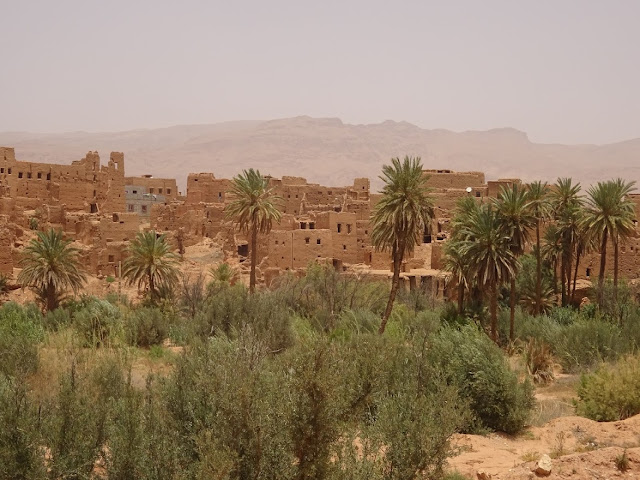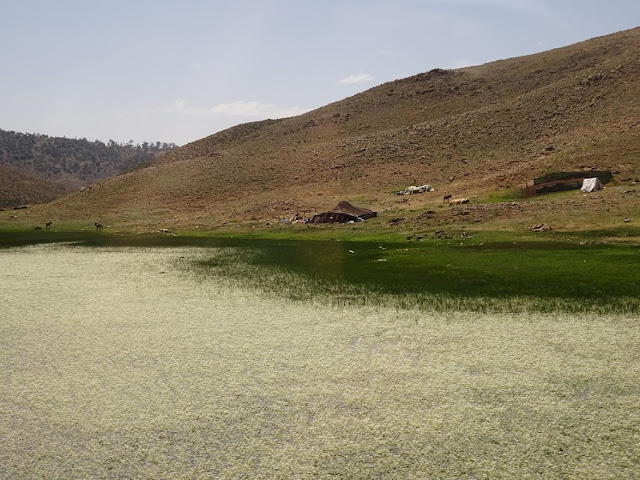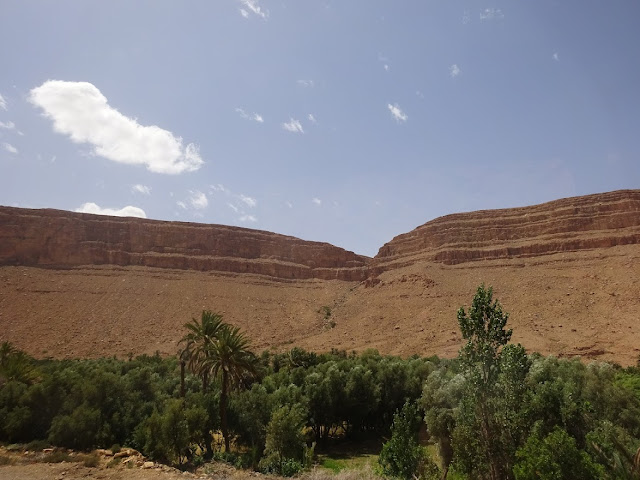The hotel even had a stable full of camels. This one wanted Tobey’s shirt!

Once we were underway, we passed miles of artesian wells, all dug by hand. We stopped at Kharret to see some of the wells. Most were dug during the 14th and 15th centuries. There is a large aquafer located about 20-30 meters under the desert.

 We stopped a little while later to take pictures of nomads who were stopped at a modern well to water their goats, donkeys and sheep.
We stopped a little while later to take pictures of nomads who were stopped at a modern well to water their goats, donkeys and sheep. Laundry is not easy for many of the people. The river in this area was used by many for that chore.
Laundry is not easy for many of the people. The river in this area was used by many for that chore.
Our route today is referred to as the “Road of a Thousand Kasbahs”, and all along the oasis there WERE thousands of kasbahs. Kasbahs are typically known as a citadel, or fortress around a city. Many of the kasbahs were built in the 14th and 15th century. They are walled buildings with living areas inside where extended families lived. Today, many, of them are abandoned and crumbling. We found them to be beautiful and mysterious and wished we had an opportunity to explore them close-up!


 When we stopped to take pictures we were met by Berber vendors, all dressed in blue. Abdulwahab, our guide, told us that they are called “blue men” because the fabric is dyed using indigo, and it used to stain their skin blue! Not so, today.
When we stopped to take pictures we were met by Berber vendors, all dressed in blue. Abdulwahab, our guide, told us that they are called “blue men” because the fabric is dyed using indigo, and it used to stain their skin blue! Not so, today.

Wendy tried her hand at bartering with one of the Berbers and came away with a beautiful pashmina.
We took a small detour and saw the Todra Gorge, the “Grand Canyon of the Sahara.” I’m not sure it resembles the Grand Canyon very much, but it was interesting geology and scenery was beautiful.


Our lunch today was at the Kasbah Lamrani Restaurant in Tinghir. The tables were set with these beautiful arrangements. They removed the cones and placed hot backed bread on the trays. A pumpkin/squash soup was followed by chicken kabobs spiced with saffron, rice, and vegetables. The dessert was orange sliced dusted with cinnamon.

 After lunch we were treated to a traditional tea making ceremony. The traditional Moroccan tea is made with green tea, mint, and lots of sugar. We were told that the average Moroccan consumes 40kg (88 pounds!) of sugar a year! They do like their sweets.
After lunch we were treated to a traditional tea making ceremony. The traditional Moroccan tea is made with green tea, mint, and lots of sugar. We were told that the average Moroccan consumes 40kg (88 pounds!) of sugar a year! They do like their sweets.
Seeing how the local people live and commute is most interesting. Donkeys, mules, and horses are used by many to transport goods.




We had a surprise stop at this Kasbah. It was built in 1722 and has been owned by one family since. The owner is a friend of our guide.


 We were able to go inside and see part of their living quarters. Three brothers and their families all live here – 18 people in total. Inside the walls were almond, walnut, apricot, olive, and fig trees, as well as flowers.
We were able to go inside and see part of their living quarters. Three brothers and their families all live here – 18 people in total. Inside the walls were almond, walnut, apricot, olive, and fig trees, as well as flowers. 
The family also has over 300 palm trees, 120 fig trees, and 5300 square meters of roses. This area is famous for its rose oil and we passed several stores in the town selling rose water perfumes, and rose products of every kind!
We continued on to Ouarazatzate and enjoyed the different scenes from the bus windows.
Students leaving school


Tajine pots for sale. Many Moroccan dishes are cooked in these conical covered ceramic dishes.

The area near Ouarzazate is the film capital of Morocco and served as a backdrop for movies like Lawrence of Arabia and Star Wars! The Kasbah below has never been lived in, it is part of a movie set.

We are finding we wish we had more time to explore these areas, but the tour departs at 8:30 tomorrow morning, so we are getting a taste of Morocco and will have to be satisfied.














































